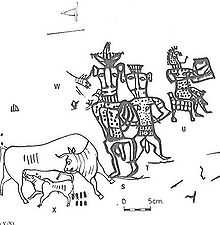Kuntillet Ajrud

| Kuntillet Ajrud | |
|---|---|
 Shown within Egypt | |
| Coordinates | 30°11′35″N 34°25′16″E / 30.19306°N 34.42111°ECoordinates: 30°11′35″N 34°25′16″E / 30.19306°N 34.42111°E |
Kuntillet Ajrud (Arabic: كونتيلة عجرود) is a late 9th/early 8th centuries BCE site in the northeast part of the Sinai peninsula.[1] It is frequently described as a shrine, but this is not certain.[2]
Excavations
The site was investigated in 1975/76 by Tel Aviv University archaeologist Ze’ev Meshel. The fortress-like main building is divided into two rooms, one large and the other small, both with low benches. Both rooms contained various paintings and inscriptions on the walls and on two large water-jars (pithoi), one found in each room. The paintings on the pithoi show various animals, stylised trees, and human figures, some of which may represent gods. They appear to have been done over a fairly considerable period and by several different artists, and do not form coherent scenes. The iconography is entirely Syrian/Phoenician and lacks any connection to the Egyptian models commonly found in Palestinian art.[3]
The inscriptions are mostly in early Hebrew with some in Phoenician script.[4] Many are religious in nature, invoking Yahweh, El and Baal, and two include the phrases "Yahweh of Samaria and his Asherah" and "Yahweh of Teman and his Asherah." [5] There is general agreement that Yahweh is being invoked in connection with Samaria (capital of the kingdom of Israel) and Teman (in Edom); this suggests that Yahweh had a temple in Samaria, and raises a question over the relationship between Yahweh and Kaus, the national god of Edom.[6] The "Asherah" is most likely a cultic object, although the relationship of this object (a stylised tree perhaps) to Yahweh and to the goddess Asherah, consort of El, is unclear.[7]
An image on the piece of pottery (belonging to a pithos vase) found at Kuntillet Ajrud is adjacent to a Hebrew inscription "Berakhti etkhem l’YHVH Shomron ul’Asherato" ("I have blessed you by Yahweh of Samaria and [his] Asherah"). Scholars disputed about the meaning and the significance of this. The two figures portrayed are generally identifiable as representing the Egyptian god Bes. Also, it is believed that this image was drawn after the inscription was written, so the two may be completely unrelated.[8]
The excavation report by Ze'ev Meshel was published in 2012.
See also
Further reading
- Shanks, Hershel. “The Persisting Uncertainties of Kuntillet ‘Ajrud.” Biblical Archaeology Review, Nov/Dec 2012.
- Ze'ev Meshel Kuntillet ‘Ajrud: An Iron Age II Religious Site on the Judah-Sinai Border (Jerusalem: Israel Exploration Society, 2012).
References
- ↑ Gnuse, Robert Karl, "No other gods: emergent monotheism in Israel" (Sheffield Academic Press, 1997) pp.69-70
- ↑ Judith M. Hadley, "The cult of Asherah in ancient Israel and Judah: evidence for a Hebrew goddess", (University of Cambridge Press, 2000) pp.108ff.
- ↑ Keel, Othmar, and Uehlinger, Christoph, "Gods, goddesses, and images of God in ancient Israel" (Fortress Press, 1998) pp.210ff.
- ↑ Bonanno, Anthony, "Archaeology and fertility cult in the ancient Mediterranean", (University of Malta, 1986) pp.238ff.
- ↑ Bonanno, Anthony, "Archaeology and fertility cult in the ancient Mediterranean", (University of Malta, 1986) pp.238ff.
- ↑ Keel, Othmar, and Uehlinger, Christoph, "Gods, goddesses, and images of God in ancient Israel" (Fortress Press, 1998) p.228.
- ↑ Keel, Othmar, and Uehlinger, Christoph, "Gods, goddesses, and images of God in ancient Israel" (Fortress Press, 1998) p.232-3.
- ↑ Puzzling Finds from Kuntillet ‘Ajrud. Biblical Archaeology Society, 10/01/2013